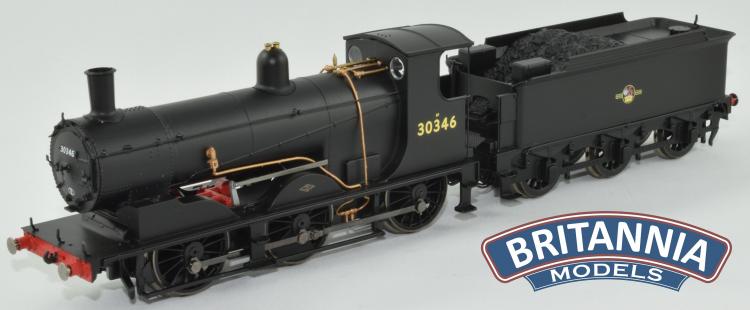BR 700 0-6-0 #30346 (Black - Late Crest) - Sold Out






Britannia Price: $169.99 Canadian RRP: $179.99 UK RRP: £124.99
DCC Ready
Locomotive 30346 entered service in August 1897 as LSWR No.711 at Strawberry Hill, being renumbered as 346 at a point between June and August 1898. At the beginning of 1917, 346 was one of three locomotives transferred to Bournemouth to assist with the vast amount of special traffic coming from the Somerset & Dorset line and in November 1923 was one of the batch of locomotives to receive the Urie modifications. By 1931, 346 was allocated to Feltham and following Nationalisation and re-numbering to 30346 in November 1949, spent most of its British Rail service allocated to 70C Guildford Shed. 30346 was withdrawn from service from 70B Feltham Shed on November 17, 1962.
..............................
In 1895, with the London and South Western Railway in desperate need of modern freight locomotives and its Locomotive Superintendent, William Adams, indisposed due to illness, Works Manager W.F Pettigrew broached the subject of ordering thirty 0-6-0 tender locomotives with the Locomotive Committee in February that year. The committee agreed in principle, expecting Adams to seek tenders for the work based on his designs, but it was to be his successor, Dugald Drummond, who got the ball rolling.
Drawing on his designs for the Caledonian Railway, the winning tender went to Dübs & Co, with a price of £2,695.00 per engine and tender (around £155,000 today) and delivery promised for June 30, 1897. Known as the “700” class or, from 1903/4, “Black Motors”, many of the components were standardised with the M7 locomotives, particularly boiler, cylinders and motion. Lever reversing, in common with locomotive and tender vacuum braking, made shunting duties quicker but the care and attention lavished on the locomotives’ appearance when they entered service meant that they were just as likely to be spotted on passenger specials or seaside excursions, as hauling main line goods duties.
With increasing levels of freight, particularly during the First World War, the 700s were seldom noted on passenger duties and many ran well over 100,000 miles between general overhauls. In 1920 the new Mechanical Engineer, Robert Urie, decided that modernisation would benefit the class and his extended smokebox, improved superheater, higher working pressure and more efficient firebox and boiler barrel positioning achieved greater locomotive efficiency, with minimal expenditure. At Grouping in 1923, all of the 700s entered the Southern’s stock book. The new CME, Richard Maunsell, put his mark upon the class with further modifications including new pattern superheaters, stove pipe chimneys and the substitution of tenders from the 700s to the D15 and T9 classes, with tenders from the D10/L11 classes being used in their place.
The entry of Maunsell’s S15 and H15 classes into traffic relieved the 700s of most of their mainline freight duties, until the Second World War intervened and the 700s returned to those duties. By Nationalisation all necessary remedial maintenance from the neglect of the war years had been carried out and all thirty locomotives entered British Rail service. Rapid decline in goods traffic, as well as local branchline and secondary lines in the early 1960s, led to a wholesale withdrawal of the class taking place in 1961 and 1962, although several of the last survivors were taken out of normal service and fitted with snow ploughs in the autumn of 1963.